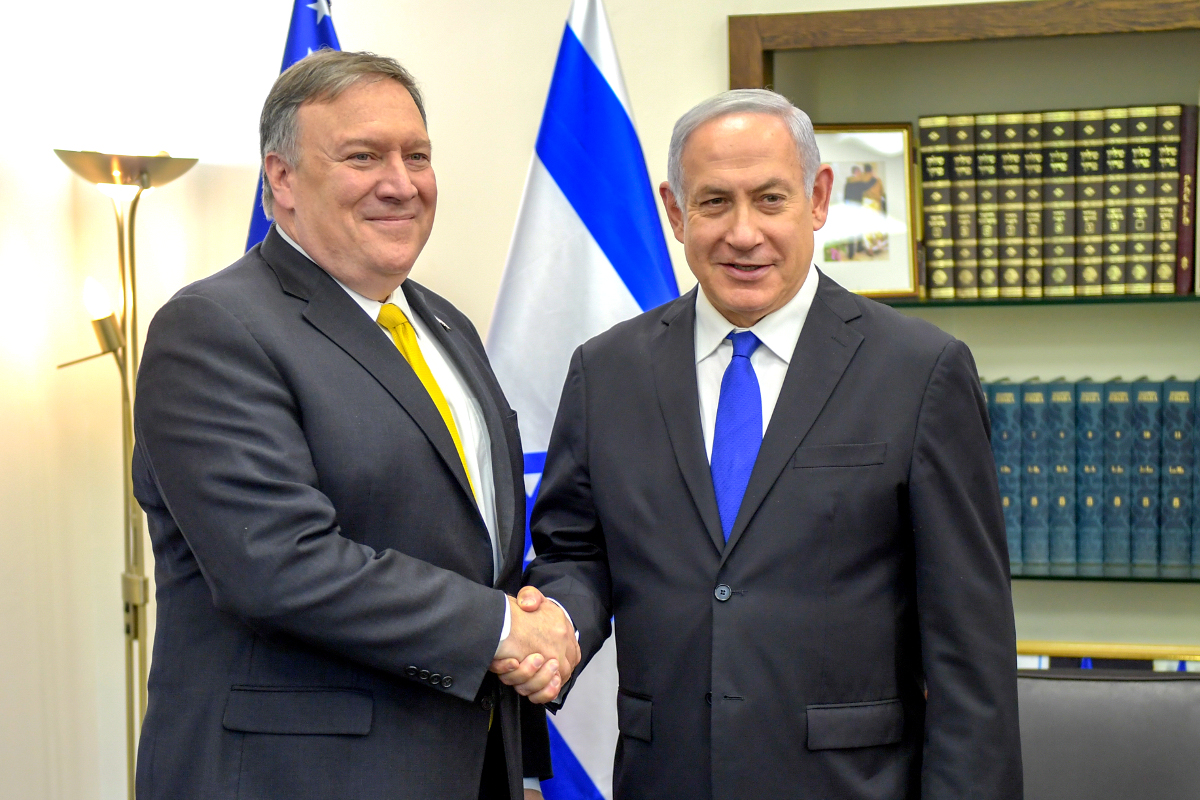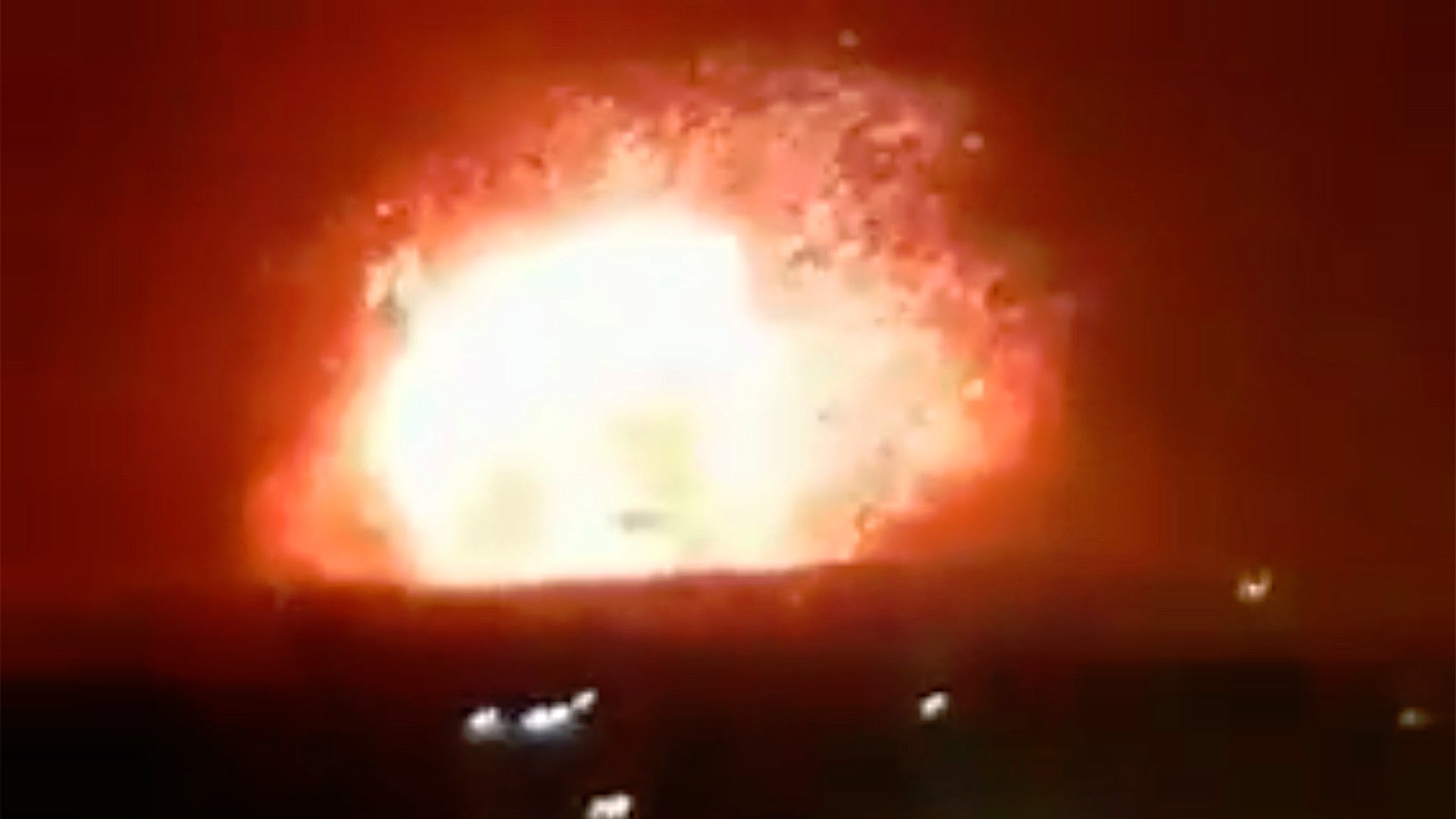Yet another foreign strike has targeted Iranian and Iranian-backed forces in Syria, this time resulting in such force it registered as a literal earthquake. Regional media outlets variously placing responsibility on Israel or the United States and the United Kingdom. After the operation, Israeli Prime Minister Benjamin Netanyahu held a major press conference excoriating Iran over its nuclear program and accusing it of lying about its compliance with an already controversial internationally-backed deal to restrict its nuclear ambitions, which might be on the verge of collapsing.
This latest bombardment occurred late on April 29, 2018, reportedly hitting the Syrian Arab Army’s 47th Brigade military base and arms depots in Salhab, both near the city of Hama, as well as Nairab Military Airport in Aleppo further to the north. On April 30, 2018, Netanyahu held an emergency meeting with his national security cabinet ahead of publicly revealing a trove of documentation regarding Iran’s nuclear weapons development programs, saying it proved Iran had been acting in bad faith despite agreeing to halt its nuclear efforts. The Israeli prime minister did not offer any clear evidence that Iran was actively building nuclear weapons in contravention of an agreement with the United States and other world powers, though.
An earth-shaking strike
A source representing the pro-Syrian government alliance that includes Iran and its proxies in the country, such as the Lebanese militant group Hezbollah, told The New York Times that the strike on the 47th Brigade facilities destroyed approximately 200 unspecified “missiles.” Unconfirmed video from local witnesses that subsequently appeared on social media showed massive explosions. The European-Mediterranean Seismological Center recorded a disturbance registering 2.6 Richter magnitude scale in the same area.
The same source also told The Times that the strikes killed 16 personnel, including nearly a dozen Iranians, in Hama. Syrian rebels claimed that nearly 40 more individuals died as stand-off weapons rained down on the 47th Brigade and the separate site in Salhab. The independent U.K.-based monitoring group Syrian Observatory for Human Rights said that its sources reported that the operation had killed nearly 30 people, including both Iranians and Iraqi Shia militiamen. Semi-official Iranian outlets acknowledged the strikes, but denied anyone had died at all. At the time of writing, there has been no official count from Iranian or Syrian officials.

The reported focus on the missiles suggests that the operation was the latest in a string of Israeli operations to, at least in part, neutralize Iranian forces and their partners in Syria from deploying advanced air defense capabilities. Earlier in April 2018, Israel reportedly destroyed one of Iran’s Russian-made Tor-M1 mobile, short-to-medium range surface-to-air missile systems in a strike against Tiyas Air Base, also known as T4, situated between the Syrian cities of Homs and Palmyra. There are reports that a Syrian Il-76 cargo plane left Iran’s Mehrabad Airport and touched down in Hama on April 28, 2018.
In the aftermath of the U.S.-led missile barrage against Syrian dictator Bashar Al Assad’s chemical weapons infrastructure on April 14, 2018, there has also been increased speculation and rumors that Iran, as well as Russia, could look to bolster the regime’s ability to ward off future attacks in general. In particular, there have been reports that the Kremlin might deliver long-range S-300 surface-to-air missile systems to Syria, or may have done so already, but so far there is no indication that those shipments have occurred or are necessarily imminent.
The Russians do appear to have sent additional Pantsir-S1 point-defense focused weapons to the country, some of which may now be under Syrian military control or otherwise deployed to support regime forces. Those systems would be well suited to at least making an attempt to shoot down incoming stand-off weapons in any future strike.
A Syrian Ministry of Defense video from earlier in April 2018 showing various air defense systems the country has in service, which does not include any evidence of S-300s from Russia.

Rumors of U.S., U.K. involvement
An initial report from at least one Syrian news outlet had also suggested that the latest strikes in Hama and Aleppo had actually been another U.S.-U.K. operation, possibly involving High Mobility Artillery Rocket Systems, or HIMARS, firing 227mm GPS-guided rockets from near the Jordanian border. If this was the case, it would likely have been in retaliation for recent pro-regime militia attacks on Syrian Democratic Forces, or SDF, a U.S.-backed, largely Kurdish force operating in Eastern Syria.
The United States has deployed HIMARS to the At Tanf garrison in Southern Syria near the Jordanian border and sites in Jordan proper. The U.S. military has also sent the weapons to Turkey and Eastern Syria.
The video below shows U.S. Army HIMARS launchers firing rockets in Syria.

However, 227mm rockets have a range of less than 40 miles, which is not nearly enough to hit targets in western Syria from any of these locations. There are no reports that American troops have employed the longer-range Army Tactical Missile System, or ATACMS, a quasi-ballistic missile, in support of its Syrian operations, which would have been able to do reach Aleppo and Hama.
There are also unconfirmed reports that Syrian or pro-Assad forces recovered various parts from GBU-39/B Small Diameter Bombs after the strikes, but Israel, as well as the United States, have these weapons. It is also possible these components are the remnants of past operations the U.S. military conducted elsewhere in Syria. For years now the U.S. military had employed the small, 250-pound class weapons in Syria, including on F-22 Raptor stealth fighters, which have been an increasingly regular sight overhead in Eastern Syria.
Whatever the case, British and American officials have both denied the country took part in any such operation on April 29, 2018, as well. Israeli officials have declined to confirm or deny that it conducted the strikes, which they do as a general rule after any such incident.
In a rare and unusual comment during an interview on Army Radio, the Israel Defense Forces official radio station, Israel’s Intelligence Minister Israel Katz did say he was “not aware” of strikes near Hama and Aleppo on April 30, 2019. “[But] all the violence and instability in Syria is the result of Iran’s attempts to establish a military presence there. Israel will not allow the opening of a northern front in Syria,” he added, echoing a well-established Israeli government position.
‘Iran, Iran, Iran’
This statement came as there were reports that Israel’s national security cabinet, which includes Katz, would hold an unscheduled meeting. Reports said this would cover developments on the country’s “northern border,” a common reference to the situation in Syria, and new information regarding Iran’s controversial nuclear program, which we will touch on in a moment.
On April 29, 2018, Israel’s fiery Defense Minister Avigdor Lieberman had made similar comments at the annual Jerusalem Post conference, declaring that Israel had three problems in the region, “Iran, Iran, [and] Iran.” He had earlier suggested Israeli forces could launch a strike if Russia delivered S-300s to Syria.
“We have no intention to attack Russia or to interfere in domestic Syrian issues,” Lieberman said at the conference, before stressing Israel would not give up “freedom of movement” on the issue. “If somebody thinks that it is possible to launch missiles or to attack Israel or even our aircraft, no doubt we will respond and we will respond very forcefully.”
And though the United States has said it was not involved, the U.S. government may have given at least tacit approval for the latest strikes. Also on April 29, 2018, newly confirmed U.S. Secretary of State Mike Pompeo, formerly Director of the Central Intelligence Agency, met with Israeli Prime Minister Benjamin Netanyahu as part of a larger visit to Israel.
“We remain deeply concerned about Iran’s dangerous escalation of threats to Israel and the region, and Iran’s ambition to dominate the Middle East remains,” Pompeo said at a shared press conference with Netanyahu. “The United States is with Israel in this fight and we strongly support Israel’s sovereign right to defend itself.”

‘Iran lied’
All of this comes as U.S. President Donald Trump and his administration step up their attacks on a multi-national deal thatcurtailed Iranian nuclear work in exchange for easing of sanctions and other incentives. Critics have said the arrangement, which previous President Barack Obama and his administration helped craft and argue for, only enabled Iran to pursue malign activities throughout the Middle East and beyond.
On April 30, 2018, following the meeting with his national security ministers, Netanyahu held a press conference in which he declared that “Iran lied” about its nuclear program and had squirreled away technical information on nuclear weapons at a secret location in its capital Tehran. Israeli intelligence services had been able to acquire more than a thousand pounds of this material, which Israel had then shared with the United States.
The disclosure of this major haul comes after the Israeli government recently declassified how it uncovered Syria’s secret nuclear weapons program and destroyed it. The decision to acknowledge that operation appeared to be, at least in part, a signal to Iran indicating Israel’s capability and willingness to take military action against its nuclear facilities, if necessary.
Codenamed Project Amad, the Iranian nuclear weapons program reportedly aimed to produce and test at least five warheads, each with a 10 kiloton yield. India, Pakistan, and North Korea detonated between five and six devices to validate their own nuclear weapons capabilities before moving to computer modeling for further nuclear warhead development. Production examples presumably would have gone on top of Iran’s longer-range ballistic missiles, which can already reach Israel.
It is worth noting that it is a largely open secret that Israel maintains its own nuclear deterrent. In addition, years of reports by the independent International Atomic Energy Agency, as well as U.S. National Intelligence Estimates, had largely concluded this was the case already. Whether or not Iran’s decision to retain the technical data after 2003, when publicly available reports suggest the country suspended its active nuclear weapons program, constitutes actually lying about maintaining such a project at all is debatable. Even if Iran had destroyed the physical documentation, it is hard to understand how it could have fully purged the knowledge base, such as the scientists themselves, that it had cultivated to produce nuclear weapons.
Death to the Iran deal
Regardless, it is likely to give more ammunition to U.S. President Donald Trump, and his administration, who has long said that he would throw out the deal if it was otherwise impossible to renegotiate the terms and “fix” it to encompass a broader set of issues. The agreement only covers Iranian nuclear activities and does not address the country’s ballistic missile development program, its support for international terrorist groups and other militants, and its continued calls for the destruction of Israel, among other things.
It is reasonable to ask why the deal, formally known as the Joint Comprehensive Plan of Action or JCPOA, does not take any of the factors into account. It is also worth questioning whether scrapping the entire existing arrangement is the best possible course of action, though it seems increasingly likely that this will be the case. Both Pompeo and Trump’s new National Security Adviser John Bolton are vehemently opposed to the deal in its present form, while Iran has it is unwilling to entertain any changes to its terms.
Both sides are increasingly accusing the other of acting in bad faith, further marring the stability of the JCPOA no matter what happens formally. The United States says Iran is not abiding by the principle of the deal in not reducing regional tensions, while Iranian authorities complain that both the U.S. government and international watchdogs have repeatedly certified that it is fully complying with the agreement’s provisions.
We at The War Zone have already written on this issue in depth and have explored what might happen should the deal final crumble. After the Trump Administration unveiled a new over-arching policy toward Iran in October 2017, I wrote:
“If the Iran Deal were to collapse, it would remove the only present impediment, no matter how weak, to Iran resuming an active and open nuclear weapons program. This, in turn, could easily prompt calls, in America and Israel in particular, for preemptive military action to neutralize this threat. There has been a significant amount of public support from policymakers and politicians for strikes against Iranian nuclear and military sites in the past.
“We at The War Zone has already explored the heavily intertwined nature of present Middle Eastern geopolitics in detail and any attack on Iranian soil could easily turn into a regional conflagration, if not touch off even broader conflicts or political disputes. The Saudis already appear to be preparing for this with the purchase of a massive ballistic missile shield that will almost certainly be pointed at Iran. The immediate sanctions against the IRGC could lead Iran to authorize more direct covert activities or otherwise increase support to groups looking to attack Americans.”
Since then, the situation in Syria has increasingly come to reflect the concerns we had already voiced, with Israel deepening its military involvement in the conflict in order to prevent Iran from establishing a firmer foothold in the region along its borders. The Trump Administration has also been investigating the possibility of turning over military activities in Eastern Syria to a coalition with Egypt or Saudi Arabia, both major opponents of Iran and its growing regional influence, at the helm.

A new conflict in Syria and beyond
Hezbollah has already said it might launch a major, outright assault on Israeli on a number of occasions over its reported strikes in Syria and did so again after the U.S., U.K., and French missiles hit Assad. The group has thousands of rockets, including some increasingly able to hit targets deep within Israel, and offers Iran a very willing proxy for responding indirectly to any threats that might follow the failure of the JCPOA.
There is also the distinct possibility that if Iran were to resume its nuclear weapons program absent the deal, that other countries in the region could follow, triggering a regional nuclear arms race. While Israel already has a nuclear arsenal, Saudi Arabia has said it would start developing its own in response to any Iranian developments. The United Arab Emirates, which is actively developing its civilian nuclear program, and Egypt, which has conducted a number of its own unreported nuclear activities, might follow suit.

Beyond the Middle East, an end to the Iran deal could have second-order effects on attempts to negotiate limits on North Korea’s nuclear and missile programs, as well as its other malign activities. South Korean President Moon Jae In and North Korean Premier Kim Jong Un recently concluded a historic summit in South Korea and Trump is set to meet with North Korea’s leader in the weeks ahead.
It is already unclear whether Kim intends to negotiate in good faith, but he is undoubtedly watching events vis-à-vis Iran as he develops his own strategy for engaging with the international community. National Security Adviser Bolton’s recent suggestion of applying a “Libya model” to North Korea, by which it gives up its entire nuclear arsenal and infrastructure in exchange for various incentives, is likely to be a non-starter in Pyongyang.
It’s not even clear if the concepts the United States employed in Libya would be workable with regards to North Korea to begin with, since the North Korean regime has actual nuclear weapons and delivery systems. The fact that the United States led an international coalition that facilitated rebels in unseating and then murdering Libyan strongman Muammar Gaddafi’s after he surrendered his nascent nuclear weapons program won’t exactly put the model in a good light to Kim, either.
But the latest apparent Israeli strikes in Syria still point to the country being “ground zero” for any immediate impact of the collapse of JCPOA, which could easily pave the way for Israel to expand its military action against Iranian forces there, possibly with increasingly direct American support. This, in turn, though, could prompt various actors, in the country and nearby, to take a more active stance in response, setting that stage for a new and potentially devastating collision of regional and global interests.
Update: 4:10pm EST—
private satellite imagery and geospatial intelligence firm ImageSat International (iSi) has now published images of the 47th Brigade’s facilities near Hama showing four separate target areas. The strikes appear to have destroyed more than a dozen individual structures.
Whatever the specific targets were, they appear to be thoroughly demolished. This aligns with what we saw in the video footage of the strikes themselves, which showed at least one massive explosion followed by a significant secondary detonation, indicating the missiles, ammunition, or other items inside one of the buildings “cooked off” after the incoming weapons hit their mark.
Contact the author: jtrevithickpr@gmail.com
